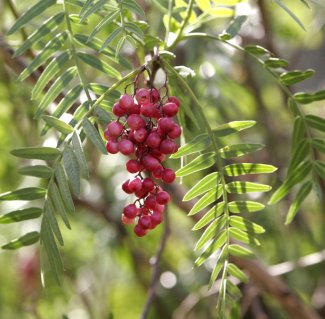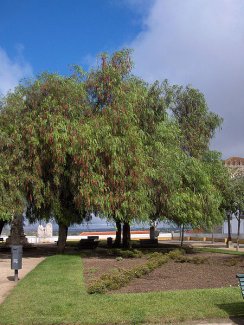Southern America Brazil: Brazil - Rio Grande do Sul, - Santa Catarina Southern South America: Argentina - Cordoba, - Catamarca, - Corrientes, - Entre Rios, - Jujuy, - La Rioja, - Misiones, - Salta, - San Luis, - Santa Fe, - Tucuman; Chile; Paraguay - Caaguazu, - Guaira, - Itapua, - Misiones; Uruguay Western South America: Bolivia - Cochabamba, - La Paz, - Potosi, - Tarija; Ecuador - Azuay, - Chimborazo, - Cotopaxi, - Imbabura, - Loja, - Pichincha, - Tungurahua; Peru - Ancash, - Arequipa, - Ayacucho, - Cajamarca, - Cuzco, - Huanuco, - Ica, - Junin, - La Libertad, - Lima, - Moquegua, - Pasco, - Tacna
An upright, aromatic, evergreen shrub or tree (family Anacardiaceae) found in central and southern California. Has drooping younger branches and grows up to 10 m tall, with alternately arranged leaves (12-25 cm long) that are once-compound and have numerous leaflets. The long and narrow leaflets (15-50 mm long and 2-10 mm wide) are mostly hairless with entire margins and pointed tips. Small white flowers are arranged in drooping branched clusters, and its fruit resemble small berries (3-6 mm across) and turn red or bluish-pink as they mature.
Peruvian peppertree has escaped cultivation to become invasive in California. This introduced species is widely grown as a garden and street tree (i.e. ornamental) in Australia. Schinus molle was first planted in California by Father Antonio Peyri in the early 1800's at Mission San Luis Rey de Francia in Oceanside California.

